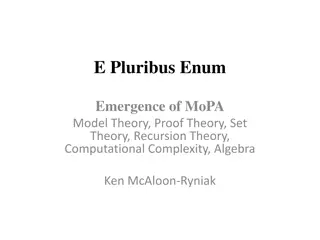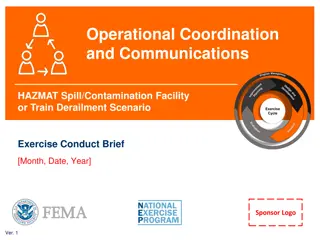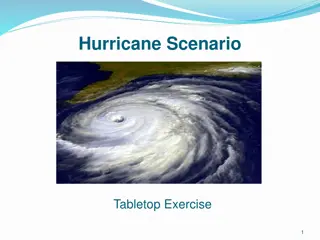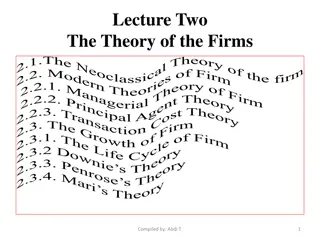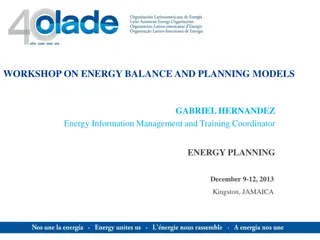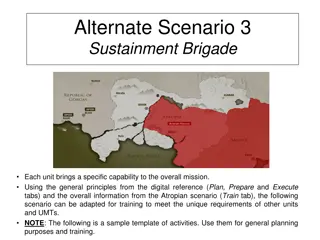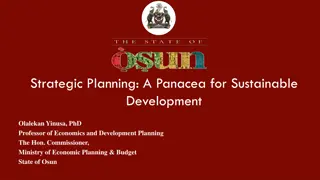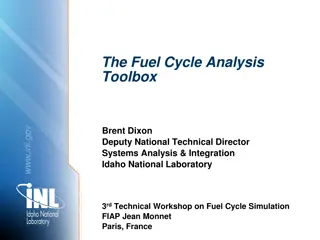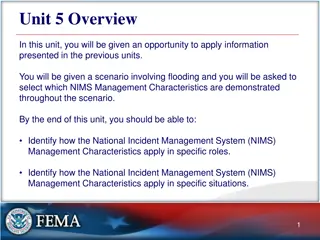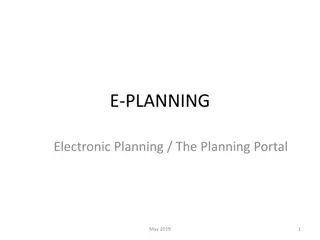Guidance for Scenario Planning: Tools and Theory
Scenario planning is vital for organizations facing uncertain futures. Learn about the theory, process, and tools involved in scenario planning, along with the importance of defining continuums and variables. This guidance aims to help small-to-medium-sized organizations understand and implement scenario planning effectively to navigate changing landscapes and build resilience.
Download Presentation

Please find below an Image/Link to download the presentation.
The content on the website is provided AS IS for your information and personal use only. It may not be sold, licensed, or shared on other websites without obtaining consent from the author.If you encounter any issues during the download, it is possible that the publisher has removed the file from their server.
You are allowed to download the files provided on this website for personal or commercial use, subject to the condition that they are used lawfully. All files are the property of their respective owners.
The content on the website is provided AS IS for your information and personal use only. It may not be sold, licensed, or shared on other websites without obtaining consent from the author.
E N D
Presentation Transcript
Guidance for Scenario Planning
Objective and Outline NCHRP 08-36 | Task 145
Guidance for Scenario Planning Scenario Planning is important because: Objective and Outline Organizations have found that a rapidly-changing future frustrates point-to-point forecasting techniques It helps transportation agencies plan for futures that are uncertain and establish signposts where plans can be reconsidered It provides a framework for the evaluation of different types of risk and risk response NCHRP 08-36 | Task 145
Guidance for Scenario Planning Objective and Outline This guidance is specifically intended to help small-to-medium-sized organizations Pass down lessons from larger organizations Disseminate best practices through the industry NCHRP 08-36 | Task 145
Guidance for Scenario Planning This presentation will: Objective and Outline Introduce the theory and terminology of Scenario Planning Walk through the process of developing a Scenario Planning study: Defining a question Identifying variables Envisioning scenarios Achieving objectives Introduce tools that assist Scenario Planning Communication and engagement tools Modeling tools NCHRP 08-36 | Task 145
Theory of Scenario Planning NCHRP 08-36 | Task 145
Continuum First, define a continuum the x axis of our plot Theory The continuum is the independent variable. What you are testing for on the y axis will change as you move from left to right. One example of a continuum is time. Another, less concrete example is a sequence of decisions. NCHRP 08-36 | Task 145
Variables Next, let s define a variable the y axis of our plot Theory Variables can be actors, factors, or sectors: Actors are people or organizations whose actions impact the future Factors are concepts, constructs, or characteristics Sectors are the arenas where actors and factors interact Let s use population, and look at it over time. NCHRP 08-36 | Task 145
Trends Anything that happens between today and a horizon, or between horizons, is a trend. Theory population time NCHRP 08-36 | Task 145
Trends Your trends might be intuitive High Theory Moderate Low population time NCHRP 08-36 | Task 145
Trends Or they could be formal informed by data or defined by you High Theory Moderate Low population time NCHRP 08-36 | Task 145
Outcomes As the continuum progresses, you may end up with discrete outcomes. Theory population time NCHRP 08-36 | Task 145
Decisions Alternatively, maybe you know the outcomes but need to describe how you get there Theory For example, you want to evaluate several potential policy decisions. development decisions NCHRP 08-36 | Task 145
Decisions You can establish decision points: Theory In this example, the first decision leads to a certain outcome if things go one way, but to two potential outcomes in the other. development That s a second decision point. decisions NCHRP 08-36 | Task 145
Scenarios Your decisions may be based on trends. Let s combine our two variables together. Scenario Policy Decision Your policies impact population growth. Theory When we reach our second horizon, we have combinations of policy and population outcomes. These are scenarios. Of course, there can be many variables and they can all interact to produce scenarios together. population Alternatively, you can define a subset of scenarios based on variables independently. We can change a policy to influence land use. We ll do it in response to population growth. time NCHRP 08-36 | Task 145
Normative Let s look at our decisions here Scenario Policy Decision Since we know what will happen when we decide a certain way, we can choose which scenario we want. Theory Thus, our policies (or investments) are determined by what we think is good. This is called normative planning. population We can change a policy to influence land use. We ll do it in response to population growth. time NCHRP 08-36 | Task 145
Explorative But what if several scenarios are equally possible? We select policies that will work for as many plausible futures as possible. Theory That s called explorative planning. population time NCHRP 08-36 | Task 145
Predictive And if we know what s going to happen and we need to be ready for it That s predictive planning. Theory population time NCHRP 08-36 | Task 145
Advice for Scenario Planning NCHRP 08-36 | Task 145
Defining a Question A question is defined by: A subject ( our region or our transit system ) A timeframe/horizon ( by 2050 ) An objective ( in order to prioritize investments ) In practice, you will combine these Fully predictive may seem to lack imagination Fully normative may seem biased Fully explorative may seem wasteful Advice Questions can be Predictive | What do we think is going to happen? Normative | How can we make something desirable happen? Explorative | What could possibly happen? NCHRP 08-36 | Task 145
Identifying Variables Commonly-cited variables adapted from NCHRP 750: Foresight Series Economics Income, unemployment, GDP, inequality Global and local trade levels, shipping, supply chains Domestic manufacturing, online retailing Transportation Transportation network companies - TNCs (Uber/Lyft), mobility as-a-service Mode choice Advice Demographics Aging population Growth rate, inward/outward migration, labor force participation Environment and Land Use Water scarcity, sea level rise, fires Emissions and air quality Development rates and open/rural land preservation Technology Printed fabrication/micromanufacture Automation in manufacturing and transportation NCHRP 08-36 | Task 145
Envisioning Scenarios Scenarios are defined by trends The current trend accelerates The current trend maintains The current trend plateaus, decelerates, or reverses Advice Scenarios can be based on A single variable, trend, or event Multiple variables interacting Land use patterns Finances Florida Department of Transportation NCHRP 08-36 | Task 145
Achieving Objectives What is your study meant to inform? What practices can we change? What rules can we make? What efforts can we empower? What investments can we make? What should our community prepare for in their lives? Prioritize what is helpful, not what is wanted most Seek help from advisors and input from engaged stakeholders Advice How you select recommended actions depends on philosophy Predictive | Future is certain, so actions address impacts Normative | Future is desirable, so actions make it more likely Explorative | Actions address as many futures as possible NCHRP 08-36 | Task 145
Tools for Scenario Planning NCHRP 08-36 | Task 145
Communication Tools The most effective tool is in-person engagement Attend fairs, block parties, other local gatherings Markers, posters, post-it notes, other low-tech feedback gathering tools Advisory committees of subject-matter and local history experts, other luminaries Tools Many types of software tools Survey (Google Forms, SurveyMonkey) Mapping (Google Maps, ArcGIS Online) Project website (Squarespace, Wix) Blogging, livestreaming, podcasting Packages (MetroQuest, Bang the Table, Public Input) Hillsborough MPO NCHRP 08-36 | Task 145
Modeling Tools For small agencies, consider the following: Take advantage of the cyclical process of long- range planning, starting small and building with each round Partnerships with State agencies (DOTs, large MPOs) who already own models and pooled fund/effort with peer agencies can spread modeling capabilities without breaking the budget Modeling tools may include: Land use models CommunityViz CorPlan EnvisonTommorow SPARC/INDEX Urbanfootprint Travel demand models Cube Emme TransCAD Visum Econometric models (REMI TransSight, TREDIS) Federal models (FHWA, EPA, CDC tools) Tools NCHRP 08-36 | Task 145
Takeaways NCHRP 08-36 | Task 145
Rules-of-Thumb Your Mind is (Mostly) Free Scenario Planning is mostly about imagining the future collaboratively with others in your organization and in your community. What do you think could happen, and what would that mean for your region? Imagining doesn t cost a dime. Takeaways Start the Conversation Every community, no matter how big or small, is full of smart folks. Public outreach and advisory committees can be very inexpensive and very high-value not only can they reveal public preferences and beliefs you may not have anticipated, they also lend your effort credibility, integrity, and approachability in the eyes of your public and stakeholders. Take Your Time and Ask for Help Your region, state, and country are full of potential partners that can pool resources or share their advantages with you. Also, Long-term planning is cyclical, and you don t need to get all the way there the first time. If you don t have the staff time to spend all at once, do one step for this LRTP and make a plan for what you ll tackle next time. NCHRP 08-36 | Task 145


